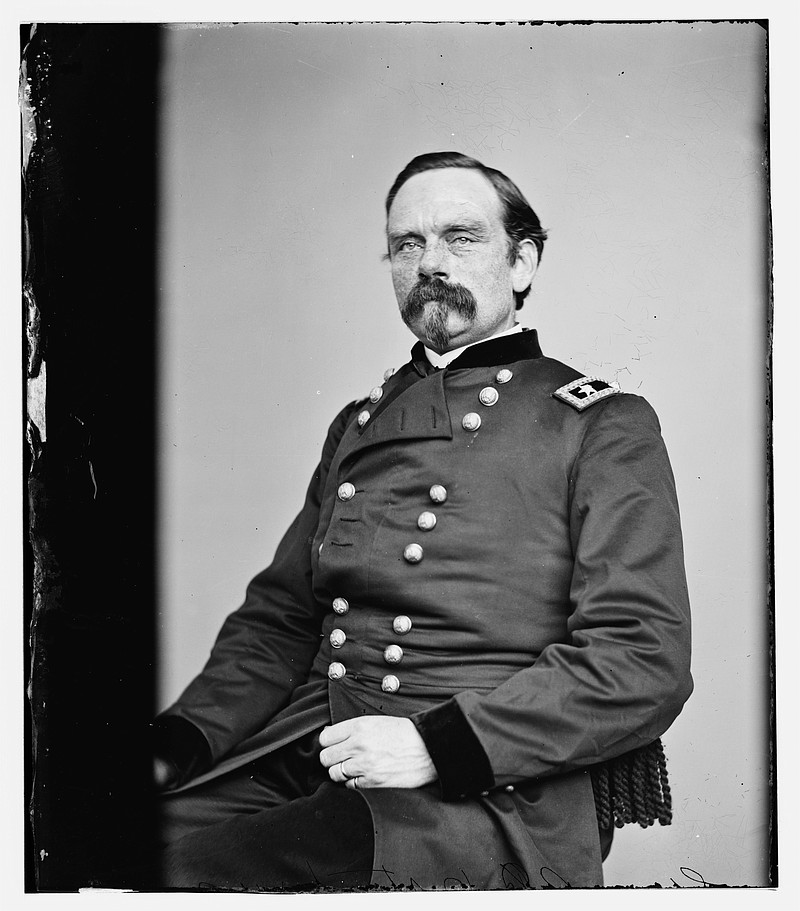Union Gen. Peter J. Osterhaus' division fought in three battles in 1863 around Chattanooga: on Nov. 24 at Lookout Mountain, on Nov. 25 at the south end of Missionary Ridge, and on Nov. 27 at Ringgold Gap.
Osterhaus, born in Koblenz, Germany, served as an officer in the Prussian army. He wound up on the wrong side during the European Revolutions of 1848 and fled to the United States. He settled in St. Louis, a magnet for German immigrants.
Civil War
View our Civil War Sequicentennial site
When the Civil War broke out, he joined the Union as a major in a volunteer unit. He quickly rose in rank to become a general under Gen. William Sherman during the Vicksburg campaign.
At Vicksburg, Osterhaus' division became known as the Vicksburg Rats because of the tunnels and trenches exploited during the siege. By the time he reached Chattanooga, his troops were battle-tested.
Osterhaus spoke English with a German accent. After a dinner of beef liver, he learned that it came from a cow illegally shot. Addressing the soldier, Osterhaus said, "Vell den, you bring me de livers, and den I know nutting about de killen."
In the Battles of Chattanooga, the general had regiments from Illinois, Ohio, Iowa and Missouri. This combination resulted in a large number of Germans in his division and a harmonious command.
Once in Chattanooga, Osterhaus' division brought up the rear of Sherman's army and never made it across the Tennessee River. The pontoon bridge had washed away.
As most of Sherman's army reached the north side of the Tennessee, Osterhaus' division was stuck on the south side and then assigned to Gen. Fighting Joe Hooker's army group.
On Nov. 24, Osterhaus aided Hooker in the capture of Lookout Mountain, playing a role in sweeping the Confederates off Craven's Terrace.
On Nov. 25, Sherman was being repulsed at the north end of Missionary Ridge by Confederate Gen. Patrick Cleburne. Hooker and Osterhaus marched to the south end of Missionary Ridge at Rossville Gap. With the bridge across Chattanooga Creek destroyed by the Confederates, Hooker and Osterhaus were delayed in arriving at Rossville Gap that afternoon. About the same time, Union forces were starting their successful assault on the Confederates in the center of Missionary Ridge.
Osterhaus' division led Hooker's column into Rossville Gap and quickly shooed away the two Confederate regiments positioned there. Osterhaus proceeded along the eastern side of the ridge and met little opposition. The single Confederate brigade blocking his way was brushed aside. By 6 p.m., Osterhaus rode his horse into what had been Gen. Braxton Bragg's headquarters.
The next day, Osterhaus' division led Hooker's Army in pursuit of the fleeing Confederates. On Nov. 27, the Union forces caught up with the tail end of the Confederates at Ringgold Gap and ran into Cleburne, who had frustrated Sherman on the north end of Missionary Ridge.
Hooker attacked with confidence. His army group had easily pushed the Confederates off Lookout Mountain and disposed of Confederate opposition on the south end of Missionary Ridge. He didn't think this would be any different.
Hooker was wrong.
Osterhaus' division led the attack into Ringgold Gap. They fought bravely from early morning until noon but were unable to dislodge Cleburne.
A single medal of honor was awarded at Ringgold. It went to Phil Goetell, a German soldier in Osterhaus' division for capturing an artillery banner and the Stars and Bars, the National Confederate Flag. The award served as a tribute to the valor of the Germans in the Federal army.
After the Union loss at Ringgold, Osterhaus participated in the Atlanta campaign and the March to the Sea. While never a public figure, Osterhaus made a name for himself within the Union Army as an energetic and resourceful commander, who led his men from the front.
He was never a self-promoter. His contribution to the success of the Union was reported almost exclusively in German-language newspapers. There was little evidence that this "Yankee Warhorse" sacrificed soldiers to gain fame.
Osterhaus later served as U.S. Consul at Lyon, France, during the Franco-Prussian War. He made his final home in Germany, at Duisberg. He died in January 1917, shortly before the United States declared war on his native country.
R. Smith Murray is a retired urologist. For more, visit www.chattahistoricalassoc.org or call LaVonne Jolley at 423-886-2090.
